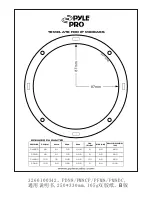
Chapter 2: Overview of the DSM1 Speaker
5
Digital Inputs
The DSM1 speaker provides an AES/EBU Digital
In connector as well as S/PDIF Digital In and
S/PDIF Digital Thru connectors.
The digital inputs accept sample rates of 44.1,
48, 88.2, 96, 176.4 and 192 kHz (+/– 10 percent)
at 16-bit or 24-bit resolution.
Only one digital input connector (AES/EBU In
or S/PDIF In) may be used at a time.
AES/EBU Digital In
The AES/EBU digital input is a female XLR con-
nector.
S/PDIF Digital In
This S/PDIF connector is for connecting digital
audio from a S/PDIF source device, or from the
S/PDIF Thru connector of another DSM1
speaker.
S/PDIF Digital Thru
This S/PDIF connector passes digital input from
either the AES/EBU Digital In or the S/PDIF Dig-
ital In connector to the S/PDIF Digital In con-
nector of another DSM1 speaker.
Digital Channel Assigment
The DSM1 speaker has a digital channel assign-
ment switch that lets you monitor the left chan-
nel, right channel, or a summed (mono) mix of
the left and right channels of the digital input.
Volume Trim Control
The Volume Trim control adjusts the level of the
input signal in the digital domain. Trim values
range from –22 dB to +10 dB.
EQ Settings
The DSM1 speaker has a series of 12 switches for
setting the following EQ controls:
High-Frequency Shelf
Sets an adjustable high fre-
quency boost or cut using a built-in HF shelf-
type EQ.
Mid-Range EQ
Sets an adjustable midrange fre-
quency boost or cut using a built-in peak/notch-
type EQ.
Low-Frequency Shelf
Sets a low frequency cut us-
ing a built-in LF shelf-type EQ, which lets you
tune the speaker’s bass response to fit your mon-
itoring environment.
High-Pass Filter
Sets a high-pass type EQ, which
lets you establish the lower limit of the speaker’s
frequency response.
Desktop 220 Hz
Cuts around a center frequency
of 220 Hz using a built-in notch-type EQ, which
lets you compensate for the effects of frequency
buildup when your DSM1 speaker is placed on a
reflective surface.
Desktop 175 Hz
Cuts around a center frequency
of 175 Hz using a built-in notch-type EQ, which
lets you compensate for the effects of frequency
buildup when your DSM1 speaker is placed on a
reflective surface.
Desktop 200 Hz
By using both the Desktop
220 Hz and the Desktop 175 Hz settings, you
can cut around a center frequency of 200 Hz to
compensate for the effects of frequency buildup
when your DSM1 speaker is placed on a reflec-
tive surface.












































